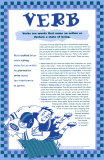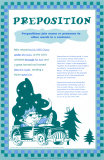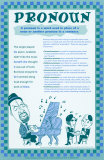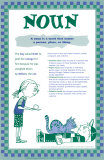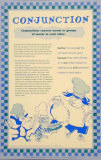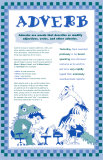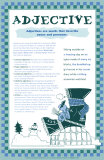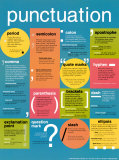|
|
|
|
|
|
Verb Poster
Verbs are words that name an action or declare a state of being.
If a group of words beginning with a capital letter and ending with a period does not have a verb, it is not a sentence. There are two crucial parts to every sentence: the subject and the predicate. The predicate tells what the subject of a sentence does, and that's the job of the verbs. In the sentence Nina ran, “Nina” is the subject and “ran” is the predicate. ”Ran” is also a verb. There are many types of verbs.
• Action verbs tell you what the subject does. Examples: run, jump, walk, write, sleep – there are hundreds of others. Action verbs tell you about physical and mental behavior in a straightforward way. an action verb can be transitive or intransitive. A transitive verb has a direct object right in the sentence. The direct object is the thing the action happens to. Transitive verbs transfer the action to the object. For example: Nina dribbled the basketball. “Dribbled” is the verb and “basketball” is the object of the sentence. Intransitive verbs do not need a direct object: Nina ran.
• Passive or linking verbs join the subjet and predicate and do not show action themselves. They tell you more about the subject rather than wht the subject is doing. The most common passive verbs are forms of to be – is, are, am, were, was, and so on. Other linking verbs: feel, look, appear, smell, taste, become. Example sentences: I am happy. This smells bad, I feel great.
• Helping verbs are added to other verbs to make the meaning of a sentence clearer. Once again, forms of be are common helping verbs. Others include should, could, will, may, might, do, does, did, have, has, had, shall. If one or more verbs uses a helping verb, it is a verb phrase. Example sentences: The man was standing in my way. You should be ashamed of yourself.
|
|
|
|
Preposition Poster
Prepositions join nouns or pronouns to other words in a sentence.
Prepositions are linking words A noun or a pronoun always comes after a preposition. This noun or pronoun is called the “object of the preposition.” Together, the preposition and its object are called a “preposition phrase.” (Note: “of the preposition” is a prepositional phrase.) In the example sentence ... the prepositional phrases are underlined.
Prepositions tend to be words that help describe something, such as a time or place. Many – but not all – prepositions are little words. Some common prepositions include: around, against, before, between, over , under, in, on, of, at, by, from, with.
|
|
|
|
Pronoun Poster
A pronoun is a word used in place of a noun or another pronoun in a sentence.
• Personal pronouns are used for a specific person, place or thing. Example sentence: Lulu went home after she saw the goat.
• Possessive pronouns show ownership. Example sentence: Lulu didn't know that the goat wasn't hers.
• Reflexive pronouns point back to a noun or pronoun earlier in the sentence. Example sentence: I asked myself, “Why am I doing this?”
• Demonstrative pronouns point out a specific noun. Example sentence: These are the costumes that Kamal wanted for the party.
• Relative pronouns are words that start a clause or phrase within a sentence. These include: that, which, who, and those. Example sentence: I never knew that the man who carried the striped umbrella.
• Indefinite pronouns are used to indicate people, places, or things without pointing to an particular one. Examples: anyone, everybody, both, either, something, nothing, any, all.
|
|
|
|
Noun Poster
A noun is a word that names a person, place, or thing.
Nouns come in four basic types: common, proper, compound, and collective.
• Common nouns name anyone of a ommon class of person, place, or thing. Examples: girl, boy, airplane, city, candy.
• Proper nouns name a speific or individula person, place, or thing, Examples: Emma, Sam, Boeing, Chicago, Cadbury. Proper nouns are usually capitalized.
• Compound nouns are two or more common nouns that act as a single noun. Compound nouns can be two separate words, or they can be hyphenated, or they can even be joined as one word. Examples: baseball, grandmother, space capsule, secretary-general.
• Collective nouns are are common nouns that name a group of things. Examples: mob, family, cult, audience.
|
|
|
|
Conjunction Poster
Conjunctions connect words or groups of words to each other.
Neither the dog nor the cat liked tomatoe sauce because they were allergic to it, but Hildy insisted on adding sauce and parmesan cheese to their pasta.
|
|
|
|
Adverb Poster
Adverbs are words that describe or modify adjectives, verbs, and other adverbs.
Adverbs change or explain adjectives, verbs, and other adverbs, making them more specific or more descriptive. They basically do the same thing that adjectives do for nouns.
Putting an adverb next to an adjective, noun or adverb helps to answer one of several questions. When?, Where?, How?, and To What Extent? or How Much? For example:
• When: It ends tomorrow.
• Where: She lived far away.
• How: I read quickly.
• To What Extent: It was perfectly round.
Most adverbs end in -ly, and this makes them easy to recognize. And you can often make an adverb out of an adjective by adding -ly to the end. For example, the word “silly” is an adjective. And many adverbs do not end in -ly.
|
|
|
|
Adjective Poster
Adjectives are words that describe nouns and pronouns.
Adjectives are words that add life to sentences. When you're trying to find them in a sentence, look for the words that describe what things are like. Adjectives answer these questions in a sentence: What kind?, How much?, Which one?, and How many? There are five kinds of adjectives.
• Common adjectives describe nouns and pronouns. Examples: A big man. A furry cat. A clumsy dancer. A fierce warrior.
• Proper adjectives are formed from proper nouns. Examples: Chinese unoirts. Nobel Prize winner. Mexican food. English princess.
• Compound adjectives are made by combining more than one word. Examples: Basketball player. One-year old child. Jumping-off point.
• Indefinite adjectives describe general quantities of nouns. Indefinite adjectives include: few, several, many, more, other, another, any, most, some. Examples: Several students were absent today. Another teacher entered the classroom. Most people like chocolate, don't they?
• Articles are adjectives because they describe nouns and pronouns. There are two types of articles: definite and indefinite. The is a definite article because it describes a specific thing: Nina dribbled the ball. A and an are called indefinite articles because they describe general things. Give me an apple please. A nation that elects its leaders is a democracy.
|
|
|
|
Punctuation Poster
period, comma, exclamation point, semicolon, parenthesis, question mark, colon, quote marks, brackets, slash, apostrophe, hyphen, dash, ellipsis
|
|
|
previous page | top | Parts of Speech Posters I | Parts of Speech II | Homophones | Punctuation
|
|
I have searched the web for visual, text, and manipulative curriculum support materials - teaching posters, art prints, maps, charts, calendars, books and educational toys featuring famous people, places and events - to help teachers optimize their valuable time and budget.
Browsing the subject areas at NetPosterWorks.com is a learning experience where educators can plan context rich environments while comparing prices, special discounts, framing options and shipping from educational resources.
Thank you for starting your search for inspirational, motivational, and educational posters and learning materials at NetPosterWorks.com. If you need help please contact us.
|
|
|







